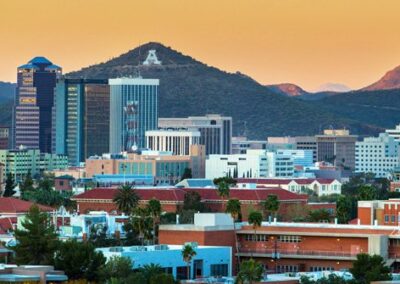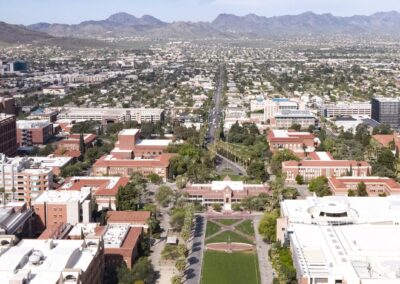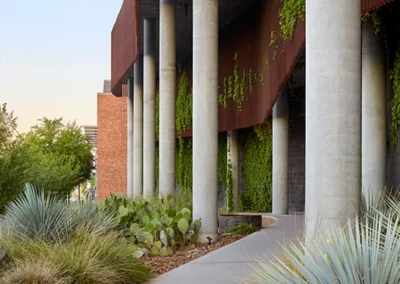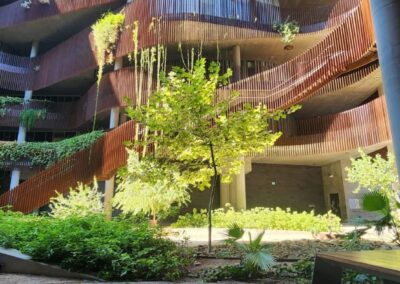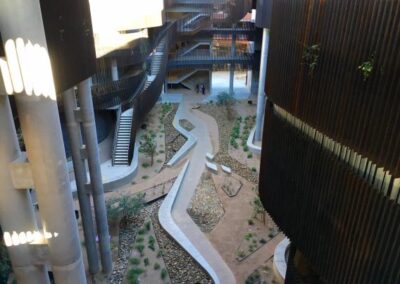
2026 ICC Location and Lodging
The ICC Conference
The 2026 conference is the 10th and final iteration of the Intercultural Competence conference. We will mark the occasion by hosting it in the Environment and Natural Resources 2 building (ENR2) on the University of Arizona campus (at 1064 E Lowell St, Tucson, AZ 85719). We selected this location because in addition to being a stunning building with the technological equipment we require, its design ties in with our 2026 theme of sustainability. Learn about the building here and take a self-guided tour of its sustainability features.
Lodging is at the Marriott University Park hotel, a short walk (less than half a mile) from the ENR2 building. The hotel is at 880 East 2nd Street, Tucson, Arizona, USA, 85719.
You can walk through the beautiful University of Arizona campus to get to ENR2, but we will provide additional options for those with mobility issues.
We have negotiated a conference rate of $219 plus taxes and fees per night (at current rates, that comes in at just under $250 in total) for reservations made by the lodging deadline of January 27. You will need the room block information in order to book at that rate–details will be here soon!
About Tucson
Located sixty miles north of the Mexican border, Tucson is the second largest city in Arizona (after the state capital of Phoenix), with roughly one million people calling the Tucson metropolitan area home. Indigenous people have lived here for more than 4,000 years, which makes Tucson one of the oldest continually inhabited areas in North America. Southern Arizona and the Tucson area form the ancestral homeland of the Tohono O’odham and Pascua Yaqui nations. Tucson’s current name derives from the one given to Sentinel Peak by the Tohono O’odham, “Ts-iuk-shan,” which refers to the fact that the base of the mountain is darker than its summit; the peak is the one with the A visible on it, in the first picture in our gallery on this page.
The varied landscape in this area includes flowering desert, rolling hills, winding dry riverbeds, rugged canyons, and pine-topped peaks, all beneath a clear blue sky (350+ days of sunshine per year). You won’t miss the saguaro cacti all over town, whose bloom is the state flower of Arizona (you’ll need to come back in May to see those though). Tucson is spectacular in the winter! While the city is at 2,389 feet above sea level and boasts average high temperatures of around 70 degrees Farenheit in February (lows of around 44 degrees), you may be fortunate to get a glimpse of snow in the Santa Catalina Mountains to the north, soaring above at 9,000 ft. Scroll to the bottom of this page to see links to a vistor’s guide and things to do in the area.
Getting around in Tucson
The Marriott University Park hotel is on the free Sunlink streetcar route (stop 14 at University Boulevard and Tyndall Avenue). During most of the day, the streetcar departs every 15 minutes (on weekdays and Saturday) or 20/30 minutes (on Sunday) from close to the hotel. There are plenty of venues near the hotel, but you can take the streetcar to restaurants and shopping further afield on 4th Avenue and Downtown, and to the western end of the streetcar route in the Mercado District. We will provide more information closer to the event dates.
Transportation between Tucson International Airport and the Marriott University Park Hotel
The hotel is about 8 miles / 15 minutes from Tucson International Airport (TUS). The hotel does not have a shuttle to the airport, but there are several other transportation options available. Click the links below for more information about a particular method of transportation:
| Uber | (estimated morning cost from TUS to the Marriott University Park hotel ~$22) |
| Lyft | (estimated morning cost from TUS to the Marriott University Park hotel ~ $23) |
| Taxis | |
| Shuttles | There are a number of shuttle companies that operate within the Tucson area. Contact a company directly for information about fares. |
| Car Rental | There are seven companies from which one can rent a vehicle at the airport. Contact a company directly for rates. |
Tucson Attractions
Below are some resources that can help you plan your trip to the Tucson area:
-
- The city’s Convention and Visitor’s bureau offers a general overview of the attractions in and around Tucson.
- The University of Arizona and the nearby University Avenue, 4th Avenue, and downtown areas have a number of restaurants and lots of shopping.
- Discover Arizona’s rich history by visiting the Arizona Historical Society. To see a list of other museums on campus ranging from anthropology to photography visit the university’s Arts & Museums page.
- The Fiesta de los Vaqueros, or the Tucson Rodeo, is taking place at the same time as our conference. Local schools are on vacation for rodeo break, a tradition that began in the days when families would be working the rodeo. Our favourite part of this event is the procession that takes place on the Thursday, billed as the world’s longest non-motorized parade.
- Tohono Chul Park is a botanical gardens with walking trails, art galleries, and a Bistro that serves southwestern cuisine and is well known to locals for its afternoon tea.
- The Arizona-Sonora Desert museum is an outdoor museum located in the Tucson Mountains (approximately 25 min driving from campus). Part museum and part zoo, it showcases the ecology of the surrounding desert and is a truly unique destination.
- Sabino Canyon is one of Tucson’s largest canyons and is just 2.5 miles from Ventana Canyon Resort. It is accessible both by tram and by foot, and usually has a river running through it in the winter. For the heartier of hikers, the Phoneline Trail and Blackett’s Ridge Trail leave the basin of Sabino Canyon for spectacular views overlooking the canyon and city.


